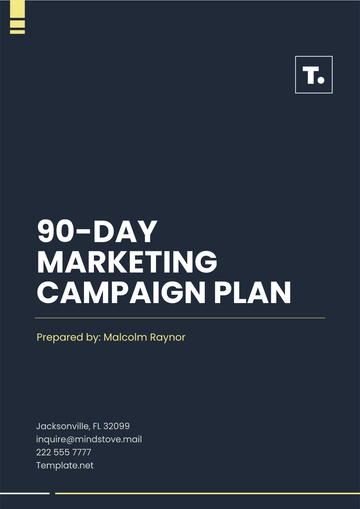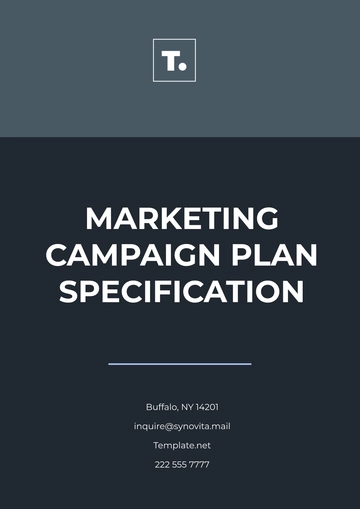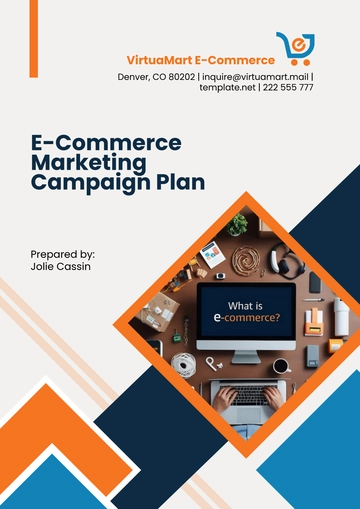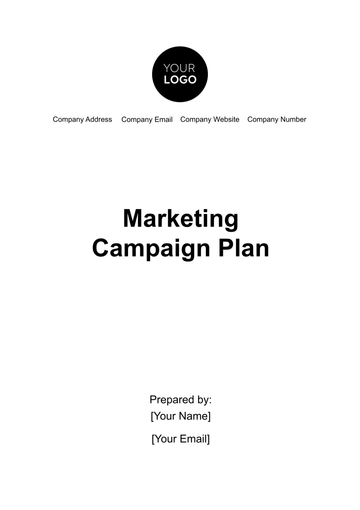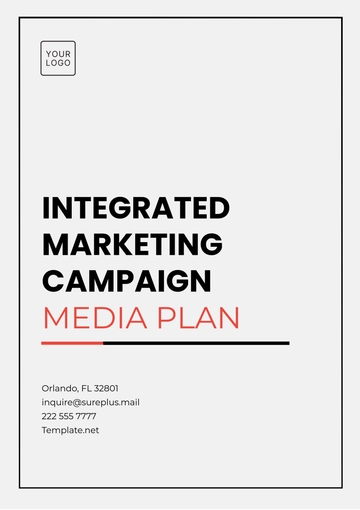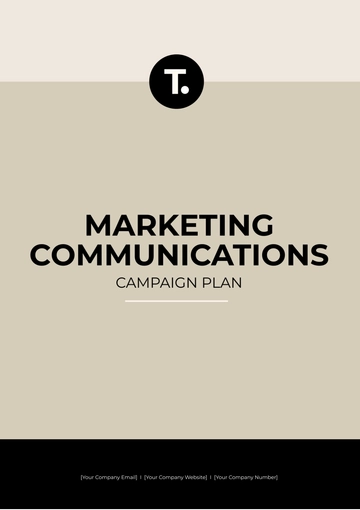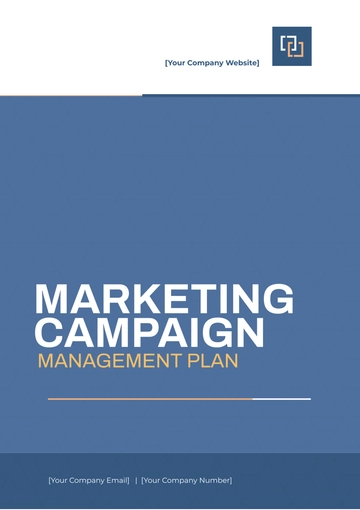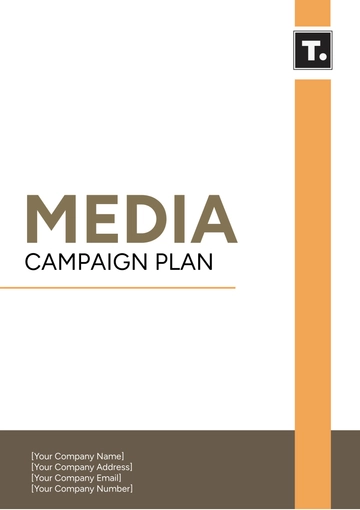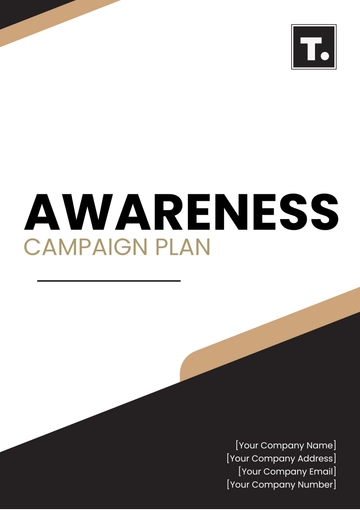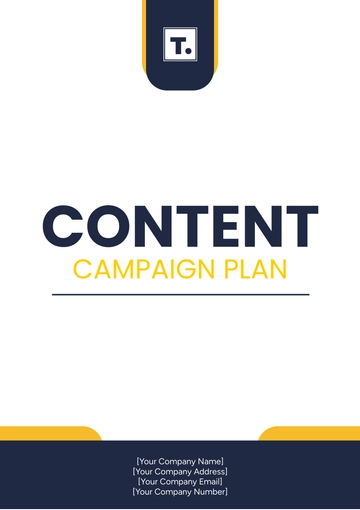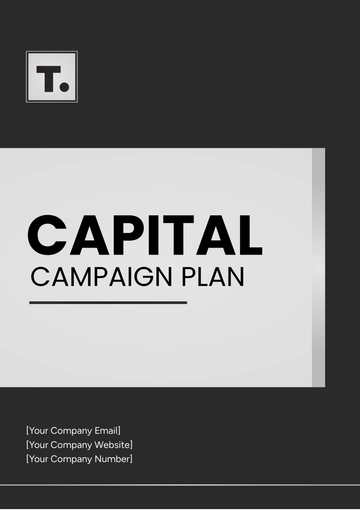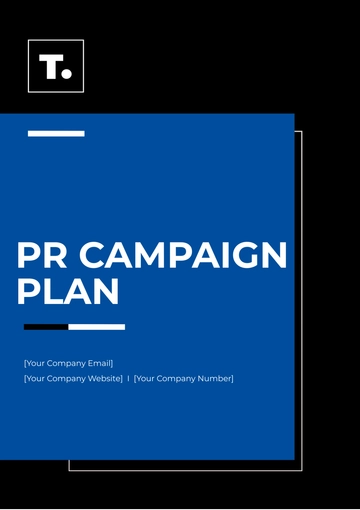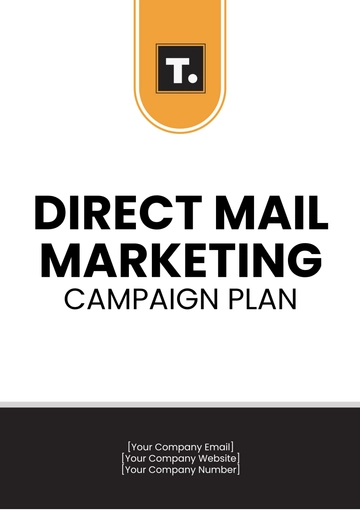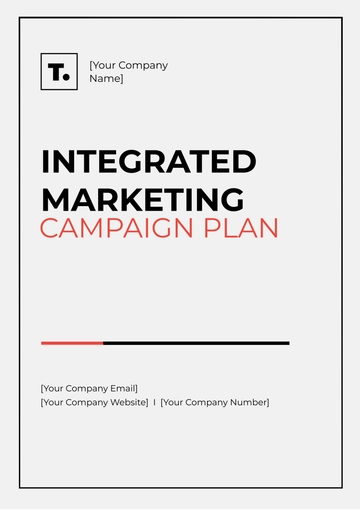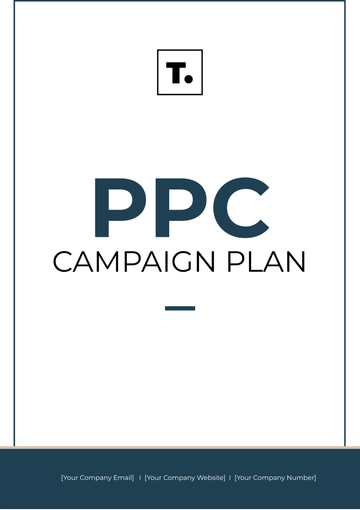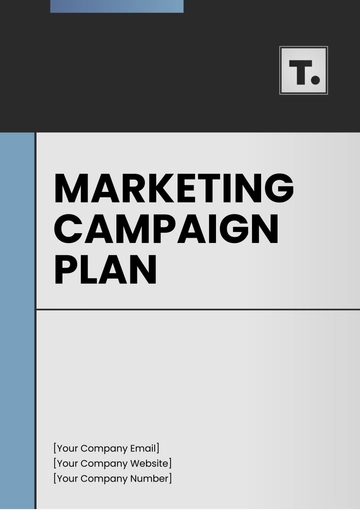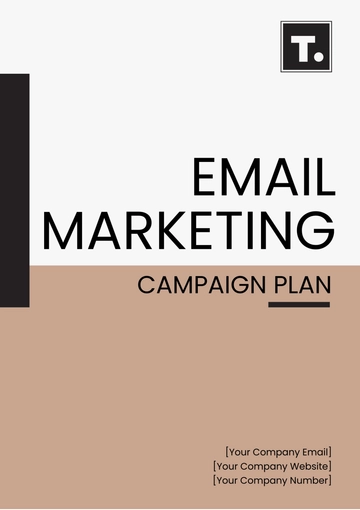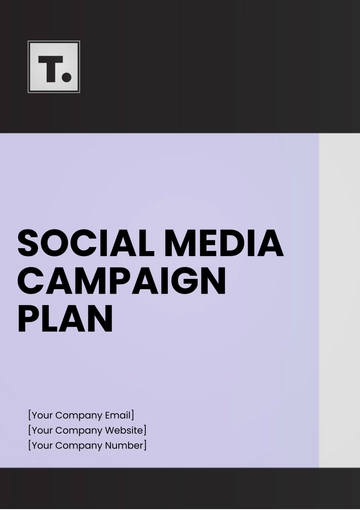Free Go-to-Marketing Campaign Plan

I. Introduction
In an era characterized by rapid technological advancements and shifting consumer behaviors, a well-structured Go-to-Market (GTM) plan has become essential for any organization looking to launch a new product or service successfully. For [Your Company Name], this GTM Campaign Plan serves as a detailed guide designed to navigate the complexities of launching our innovative product in a competitive marketplace. It aims to maximize market penetration, drive revenue growth, and foster customer acquisition from the outset.
This document outlines comprehensive strategies, tactical approaches, and actionable steps required to ensure the product’s success in the market from 2050 onwards. With increasing competition and evolving customer expectations, a robust GTM strategy will serve as our foundation for sustainable growth and profitability in the years to come.
II. Objectives and Goals
The objectives and goals outlined below are strategically designed to provide [Your Company Name] with clear direction and measurable outcomes throughout the GTM campaign.
A. Revenue Generation
Achieve Revenue Goals
Our primary financial objective is to generate [$50 million] in revenue within the first [12 months] post-launch. This ambitious target will be achieved through a carefully coordinated sales and marketing strategy that targets key market segments effectively. The financial success of this campaign will allow us to reinvest in product development and marketing initiatives, ensuring sustained growth.Expand Market Share
By the end of the year 2052, our goal is to capture [15%] of the total addressable market (TAM) for our product. This positioning will not only elevate [Your Company Name] as one of the leading providers in the industry but will also create opportunities for strategic partnerships and collaborations that can further enhance our market standing.
B. Customer Acquisition
Increase Customer Base
The campaign aims to onboard [10,000 new customers] within the first [18 months]. To achieve this, we will implement targeted marketing strategies and promotional offers that appeal to our identified customer personas. Successfully attracting a diverse customer base will be crucial for building brand loyalty and advocacy.Customer Retention Rate
We aim to achieve a customer retention rate of [85%] within [24 months]. This focus on retention will ensure that we not only attract new customers but also foster long-term relationships that lead to repeat business, referrals, and an engaged community around our brand.
C. Brand Awareness
Brand Recognition
Strengthening the recognition of [Your Company Name] is imperative, with a target of increasing brand awareness among our target demographics by [40%] within [6 months]. Enhanced brand visibility will position us as a thought leader in the industry, driving trust and credibility with potential customers.
III. Target Market Analysis
Identifying and understanding our target market segments is critical for crafting a successful GTM campaign. This section provides a detailed analysis of the various customer segments that [Your Company Name] intends to target.
A. Market Segmentation
Demographic Segmentation
The product is primarily aimed at tech-savvy professionals aged [25-45] who reside in urban areas. This demographic is characterized by a higher level of education, disposable income, and a propensity to adopt new technologies quickly. Understanding their motivations and pain points will allow us to tailor our messaging effectively.Geographic Segmentation
Our initial launch will concentrate on North America, particularly in high-density urban centers such as New York, Los Angeles, Chicago, and Toronto. The rationale behind this focus is the higher concentration of our target demographic, coupled with their propensity for adopting innovative solutions. Following a successful launch, we plan to expand into European markets, such as London and Berlin, and Asian markets, including Tokyo and Singapore, by 2051.Psychographic Segmentation
Our target audience consists primarily of early adopters who prioritize innovation, efficiency, and digital solutions in both their personal and professional lives. These individuals often seek out the latest technologies that enhance their productivity and enable them to work smarter, not harder. Understanding their lifestyle choices, values, and interests will allow us to engage them more effectively through targeted marketing campaigns.
B. Customer Personas
To illustrate our target market further, we have developed detailed customer personas that encapsulate the characteristics and motivations of our ideal customers:
Persona 1: The Tech-Savvy Professional
Age: [28-40]
Profession: IT Manager or Software Developer
Key Motivations: This persona is driven by the desire to streamline workflow, increase productivity, and stay ahead of technology trends. They seek tools that offer advanced functionalities while being easy to use.
Challenges: Often overwhelmed with managing multiple tasks, this persona desires better tools that optimize performance without adding complexity to their workflow.
Persona 2: The Digital Native Entrepreneur
Age: [30-45]
Profession: Startup Founder or Small Business Owner
Key Motivations: Focused on increasing business efficiency, boosting team collaboration, and implementing new technologies that can scale operations. They value solutions that provide immediate ROI and long-term benefits.
Challenges: Faces time constraints and budget limitations while trying to balance growth with operational challenges. This persona is often looking for affordable yet powerful solutions that can drive their business forward.
C. Total Addressable Market (TAM)
The total addressable market for [Your Company Name]'s product in North America is valued at approximately [$5 billion] annually. Given the increasing interest in digital transformation solutions and advancements in technology, the TAM is projected to grow at a compound annual growth rate (CAGR) of [8%] through 2055. This growth presents significant opportunities for [Your Company Name] to capture market share and drive long-term revenue growth.
IV. Competitive Landscape Analysis
Understanding the competitive landscape is crucial for identifying potential threats and opportunities that [Your Company Name] may face in the market. A thorough analysis of competitors will inform our strategies and help us differentiate our product effectively.
A. Competitor Overview
Competitor 1: Tech Innovators Corp
Market Share: [20%] of the TAM
Strengths: Tech Innovators Corp boasts a well-established brand with a loyal customer base and a robust research and development department. Their strong financial backing allows for continual innovation.
Weaknesses: However, they have been slow to adopt emerging market trends, which has resulted in some of their offerings becoming outdated and less appealing to tech-savvy consumers.
Competitor 2: Future Solutions LLC
Market Share: [12%]
Strengths: Future Solutions LLC enjoys high customer satisfaction rates and is known for innovative product designs that resonate with consumers. They have built a reputation for quality and reliability in their offerings.
Weaknesses: Despite their strengths, their limited global presence makes them vulnerable to larger international players who can leverage their economies of scale and resources.
B. SWOT Analysis for [Your Company Name]
A comprehensive SWOT (Strengths, Weaknesses, Opportunities, Threats) analysis will help [Your Company Name] understand its position within the market and inform strategic decision-making:
Strengths | Weaknesses |
|---|---|
Cutting-edge technology with unique features that solve real problems for users. | Limited brand recognition in international markets, which may hinder initial sales efforts. |
A strong development team with expertise in AI and automation technologies, enabling rapid innovation. | Initial high cost of customer acquisition due to aggressive marketing strategies and investment in brand building. |
Strategic partnerships with major technology firms that can enhance product capabilities and market reach. | The need for scaling infrastructure rapidly to meet anticipated demand without sacrificing quality. |
Opportunities | Threats |
|---|---|
Growing market demand for digital transformation solutions as organizations seek to optimize operations. | Potential competitor price wars that could erode margins and make it difficult to maintain profitability. |
Expansion into international markets that are experiencing rapid growth in technology adoption. | Rapidly changing technology trends that may require continuous adaptation and investment in R&D. |
Strategic mergers and acquisitions that could bolster product offerings and market share. | Regulatory challenges in specific regions that may create barriers to entry or additional costs. |
V. Product Positioning Strategy
The product positioning strategy for [Your Company Name] is designed to clearly articulate the product’s unique value proposition and competitive advantages in a crowded marketplace. This section outlines our approach to effectively communicate the product’s benefits to our target audience.
A. Unique Selling Proposition (USP)
[Your Company Name] offers a cutting-edge digital platform that significantly enhances productivity and streamlines collaboration for tech-driven organizations. Our solution stands out in the market due to its advanced AI-driven automation features, seamless integration capabilities with existing systems, and superior user experience. This compelling USP will resonate with our target audience, making our product a preferred choice among competitors.
B. Key Differentiators
AI-Driven Automation
Our platform leverages state-of-the-art AI to automate mundane tasks, enabling users to focus on high-impact work that drives business value. This feature not only saves time but also reduces the likelihood of human error, contributing to higher productivity levels.Seamless Integration
The product integrates effortlessly with widely-used software suites, such as Microsoft 365 and Google Workspace, allowing for a smooth onboarding process. By minimizing disruptions, we ensure that users can begin leveraging the platform's capabilities immediately.User-Centric Design
With a focus on user experience, our platform is designed for intuitiveness and ease of use. Detailed onboarding processes and continuous user support will empower customers to utilize the product to its fullest potential.
C. Brand Messaging
Our brand messaging will focus on the themes of innovation, efficiency, and user empowerment. We will highlight how our product enables users to reclaim their time and resources, fostering a culture of productivity within their organizations. Messaging will be tailored to address the specific needs and pain points of our customer personas, ensuring resonance with our target audience.
VI. Marketing Strategy
The marketing strategy for the GTM campaign is pivotal in generating awareness, attracting leads, and converting prospects into loyal customers. This section outlines the multi-faceted marketing approach that [Your Company Name] will adopt to achieve our objectives.
A. Marketing Channels
Digital Marketing
Our digital marketing efforts will encompass various channels, including search engine optimization (SEO), pay-per-click (PPC) advertising, content marketing, and email marketing. These channels will be essential for generating organic traffic, increasing visibility, and driving conversions.SEO Strategy: By optimizing our website and content for relevant keywords, we aim to improve organic search rankings, making it easier for potential customers to discover our offerings. Our goal is to rank within the top [3] search results for key industry terms by 2051.
PPC Advertising: Targeted ad campaigns on platforms such as Google Ads and social media will drive immediate traffic to our website, helping us capture leads quickly. We will allocate approximately [$800,000] of our marketing budget to PPC efforts.
Content Marketing
Content marketing will play a significant role in establishing [Your Company Name] as a thought leader in the industry. We will create high-quality, informative content such as blog posts, whitepapers, case studies, and videos that resonate with our target audience.Content Calendar: A detailed content calendar will be developed to ensure consistent publishing and promotion of content across various channels. This will include blog articles released bi-weekly, monthly webinars, and quarterly e-books on relevant topics in digital transformation.
SEO-Optimized Content: All content will be crafted with SEO best practices in mind, ensuring that it attracts organic traffic and positions [Your Company Name] as an authority in the industry.
Social Media Marketing
Leveraging social media platforms such as LinkedIn, Twitter, and Facebook will be crucial for engaging with our target audience and promoting our content.Engagement Strategies: We will share industry insights, product updates, and customer success stories to build community and foster engagement. Regular interaction with followers through Q&A sessions and polls will help us understand their needs better.
Paid Social Advertising: We will utilize paid social media advertising to target specific demographics and drive traffic to our website, budgeted at [$300,000].
B. Marketing Tactics
Influencer Marketing
Collaborating with industry influencers will help amplify our reach and credibility. We will identify and engage with key influencers who resonate with our target audience, securing partnerships for product reviews, testimonials, and social media promotion.Email Marketing
Email marketing campaigns will be designed to nurture leads, promote content, and announce product updates. We will segment our email list based on customer personas to ensure personalized and relevant communication.Drip Campaigns: Automated drip campaigns will educate leads about our product's features and benefits while guiding them toward making a purchase decision.
Events and Webinars
Hosting webinars and participating in industry conferences will provide opportunities for direct engagement with potential customers and industry stakeholders.Educational Webinars: We will organize quarterly webinars featuring industry experts discussing trends and best practices related to our product's application, thereby generating interest and leads.
VII. Public Relations (PR) and Press
Effective public relations (PR) strategies will be instrumental in generating buzz and increasing visibility for [Your Company Name] during the GTM campaign. By fostering relationships with the media and industry stakeholders, we can enhance our reputation and credibility.
A. Press Releases
Product Launch Announcement
We will issue a press release to announce the official product launch, highlighting its unique features and benefits. This press release will be distributed to major tech publications such as TechCrunch, Wired, and Forbes, targeting both print and digital outlets to maximize reach.Strategic Timing
The press release will coincide with key milestones in the campaign, such as product demonstrations, webinars, and significant partnerships. This timing will ensure that media coverage aligns with our marketing activities and amplifies our message.
B. Media Appearances
Interviews and Guest Articles
Securing interviews with influential journalists and contributing guest articles to reputable business and technology media outlets will further establish [Your Company Name] as a thought leader. This strategy will help us articulate our vision, showcase industry expertise, and drive credibility in the eyes of potential customers.Press Kit Development
A comprehensive press kit will be created, including product information, company background, executive bios, and high-resolution images. This will facilitate media outreach and ensure that journalists have access to all the necessary information to write compelling stories about our product and company.
VIII. Sales Strategy
A well-defined sales strategy is paramount for the GTM campaign's success. Our sales initiatives will be tightly aligned with our marketing efforts to ensure a unified approach toward achieving revenue and growth goals.
A. Sales Team Structure
Inside Sales
Our inside sales team will be responsible for handling inbound leads generated from marketing campaigns. This team will conduct product demonstrations, follow up with prospects, and close deals primarily targeting small to mid-sized businesses.Lead Qualification: The team will utilize lead scoring methodologies to prioritize leads based on their likelihood to convert, ensuring that sales resources are focused on high-potential opportunities.
Enterprise Sales
A dedicated enterprise sales team will manage relationships with large corporate clients. This team will offer personalized solutions, conduct on-site demonstrations, and engage in consultative selling practices to address complex business needs.Account-Based Selling: The enterprise team will adopt an account-based selling approach, where they will develop tailored strategies for high-value accounts, fostering deeper relationships and long-term partnerships.
B. Sales Enablement
To equip the sales team with the necessary tools and resources, we will provide comprehensive sales enablement materials, including:
Sales Playbooks
Detailed sales playbooks will be created, outlining key product features, competitive advantages, and objection-handling strategies. These playbooks will serve as a reference guide for sales representatives during their interactions with prospects.Product Demos
High-quality product demonstration videos will be produced, showcasing the platform's capabilities and use cases. These resources will enable the sales team to convey the product's value proposition effectively during sales pitches.Case Studies
Compelling case studies highlighting successful implementations and customer outcomes will be developed. These case studies will serve as social proof and help build trust with potential customers.
C. Sales Goals
The sales team will have ambitious targets to drive revenue growth:
First-Year Sales Goal
The team will aim to close [$10 million] worth of new business in the first [12 months]. This goal will require diligent prospecting, effective follow-up, and a commitment to delivering exceptional customer experiences.Scaling Up
Following the initial year, we plan to scale our sales efforts to achieve a total revenue goal of [$50 million] in the second year. This growth will necessitate expanding the sales team, enhancing training programs, and optimizing sales processes to maximize efficiency and effectiveness.
IX. Budget Allocation
Effective budget allocation is critical to ensure that the GTM campaign remains financially viable and achieves its objectives efficiently. Below is a detailed breakdown of the budget allocation for each major activity, accompanied by justifications for each category:
Category | Budget ($) | % of Total Budget | Justification |
|---|---|---|---|
Digital Marketing (SEO, PPC) | [$2 million] | [40%] | A significant portion of our budget is allocated to digital marketing to drive brand awareness and generate leads. This will include SEO optimization efforts and targeted PPC campaigns to capture immediate interest in our product. |
Content Marketing | [$500,000] | [10%] | Content marketing is essential for establishing thought leadership and educating our audience about the product. The budget will cover the creation of high-quality content and distribution across various platforms. |
Social Media Campaigns | [$300,000] | [6%] | Investment in social media campaigns will enhance engagement with our target audience and help build a community around our brand. This budget will support both organic and paid social initiatives. |
Sales Enablement | [$1 million] | [20%] | Providing sales teams with the right tools and resources is critical for success. This budget will fund the development of sales materials, product demos, and training programs. |
Product Development | [$1.2 million] | [24%] | Ongoing investment in product development is necessary to ensure continuous improvement and innovation. This budget will support R&D efforts, including feature enhancements based on customer feedback. |
X. Measurement and Metrics
Measuring the effectiveness of the GTM campaign is crucial to ensuring that [Your Company Name] meets its objectives. We will track key performance indicators (KPIs) across all phases of the campaign to evaluate success and make data-driven adjustments as necessary.
A. Key Performance Indicators (KPIs)
Revenue Growth
Tracking monthly revenue growth will provide insights into sales performance and overall financial health. Our goal is to achieve a [20%] month-over-month growth rate for the first [6 months].Customer Acquisition Cost (CAC)
Monitoring CAC will allow us to assess the efficiency of our marketing and sales efforts. Our target CAC should not exceed [$200] per customer acquired.Conversion Rate
The conversion rate from leads to paying customers will be closely monitored to gauge the effectiveness of our marketing strategies and sales tactics. A target conversion rate of [5%] is anticipated.Customer Satisfaction Score (CSAT)
Regularly surveying customers to gauge satisfaction will help us identify areas for improvement. Our goal is to achieve a CSAT score of [90%] or higher.
B. Reporting and Analysis
Monthly Performance Reviews
The marketing and sales teams will conduct monthly performance reviews to evaluate progress against KPIs, analyze campaign effectiveness, and identify any necessary adjustments.Data-Driven Decision-Making
Leveraging analytics tools and customer feedback, we will make data-driven decisions to optimize marketing and sales strategies. Continuous iteration based on performance data will ensure that we remain agile and responsive to market conditions.
XI. Conclusion
The Go-to-Market Campaign Plan for [Your Company Name] outlines a comprehensive approach to successfully launching our innovative product in the year 2050 and beyond. By focusing on clear objectives, thorough market analysis, strategic positioning, and effective marketing and sales tactics, we are well-positioned to achieve our goals.
As the market continues to evolve, so must our strategies. We commit to ongoing assessment, adaptation, and investment in both our product and our marketing efforts to ensure sustainable growth. By maintaining a customer-centric approach and leveraging technological advancements, [Your Company Name] will solidify its position as a leader in the industry, driving innovation and delivering exceptional value to our customers.
The successful execution of this GTM campaign will lay a solid foundation for long-term success, establishing [Your Company Name] as a trusted partner for organizations looking to embrace the future of digital transformation.
- 100% Customizable, free editor
- Access 1 Million+ Templates, photo’s & graphics
- Download or share as a template
- Click and replace photos, graphics, text, backgrounds
- Resize, crop, AI write & more
- Access advanced editor
Maximize your marketing efforts with the Go-to-Marketing Campaign Plan Template from Template.net. This editable and customizable template allows you to outline campaign goals, target audiences, and tactics effectively. Use our Ai Editor Tool to personalize your plan, ensuring your marketing campaigns resonate with your audience.
You may also like
- Finance Plan
- Construction Plan
- Sales Plan
- Development Plan
- Career Plan
- Budget Plan
- HR Plan
- Education Plan
- Transition Plan
- Work Plan
- Training Plan
- Communication Plan
- Operation Plan
- Health And Safety Plan
- Strategy Plan
- Professional Development Plan
- Advertising Plan
- Risk Management Plan
- Restaurant Plan
- School Plan
- Nursing Home Patient Care Plan
- Nursing Care Plan
- Plan Event
- Startup Plan
- Social Media Plan
- Staffing Plan
- Annual Plan
- Content Plan
- Payment Plan
- Implementation Plan
- Hotel Plan
- Workout Plan
- Accounting Plan
- Campaign Plan
- Essay Plan
- 30 60 90 Day Plan
- Research Plan
- Recruitment Plan
- 90 Day Plan
- Quarterly Plan
- Emergency Plan
- 5 Year Plan
- Gym Plan
- Personal Plan
- IT and Software Plan
- Treatment Plan
- Real Estate Plan
- Law Firm Plan
- Healthcare Plan
- Improvement Plan
- Media Plan
- 5 Year Business Plan
- Learning Plan
- Marketing Campaign Plan
- Travel Agency Plan
- Cleaning Services Plan
- Interior Design Plan
- Performance Plan
- PR Plan
- Birth Plan
- Life Plan
- SEO Plan
- Disaster Recovery Plan
- Continuity Plan
- Launch Plan
- Legal Plan
- Behavior Plan
- Performance Improvement Plan
- Salon Plan
- Security Plan
- Security Management Plan
- Employee Development Plan
- Quality Plan
- Service Improvement Plan
- Growth Plan
- Incident Response Plan
- Basketball Plan
- Emergency Action Plan
- Product Launch Plan
- Spa Plan
- Employee Training Plan
- Data Analysis Plan
- Employee Action Plan
- Territory Plan
- Audit Plan
- Classroom Plan
- Activity Plan
- Parenting Plan
- Care Plan
- Project Execution Plan
- Exercise Plan
- Internship Plan
- Software Development Plan
- Continuous Improvement Plan
- Leave Plan
- 90 Day Sales Plan
- Advertising Agency Plan
- Employee Transition Plan
- Smart Action Plan
- Workplace Safety Plan
- Behavior Change Plan
- Contingency Plan
- Continuity of Operations Plan
- Health Plan
- Quality Control Plan
- Self Plan
- Sports Development Plan
- Change Management Plan
- Ecommerce Plan
- Personal Financial Plan
- Process Improvement Plan
- 30-60-90 Day Sales Plan
- Crisis Management Plan
- Engagement Plan
- Execution Plan
- Pandemic Plan
- Quality Assurance Plan
- Service Continuity Plan
- Agile Project Plan
- Fundraising Plan
- Job Transition Plan
- Asset Maintenance Plan
- Maintenance Plan
- Software Test Plan
- Staff Training and Development Plan
- 3 Year Plan
- Brand Activation Plan
- Release Plan
- Resource Plan
- Risk Mitigation Plan
- Teacher Plan
- 30 60 90 Day Plan for New Manager
- Food Safety Plan
- Food Truck Plan
- Hiring Plan
- Quality Management Plan
- Wellness Plan
- Behavior Intervention Plan
- Bonus Plan
- Investment Plan
- Maternity Leave Plan
- Pandemic Response Plan
- Succession Planning
- Coaching Plan
- Configuration Management Plan
- Remote Work Plan
- Self Care Plan
- Teaching Plan
- 100-Day Plan
- HACCP Plan
- Student Plan
- Sustainability Plan
- 30 60 90 Day Plan for Interview
- Access Plan
- Site Specific Safety Plan




